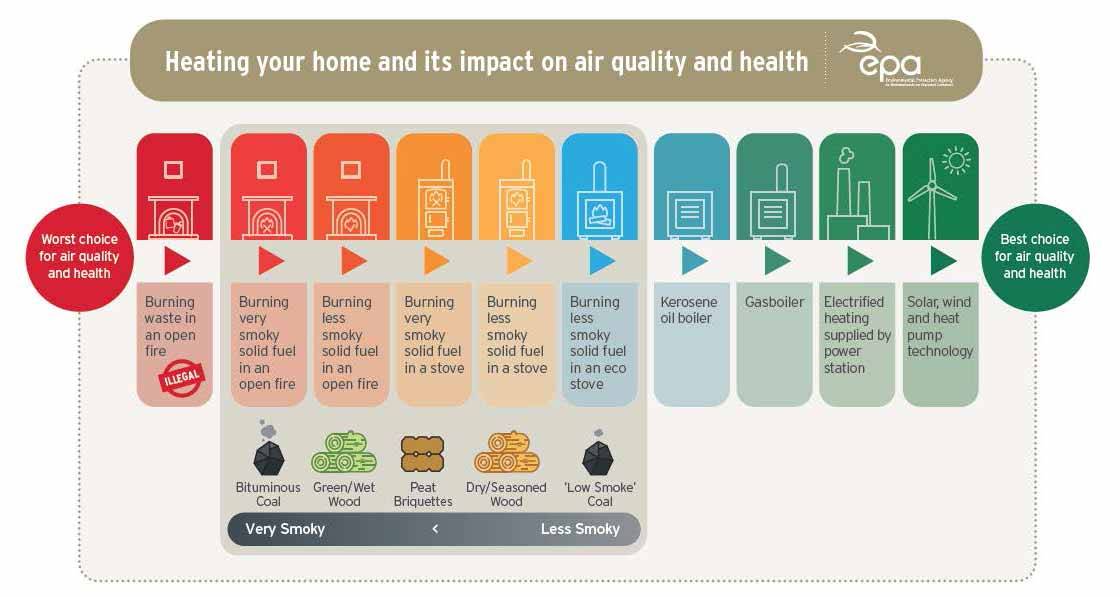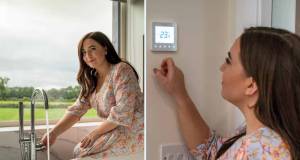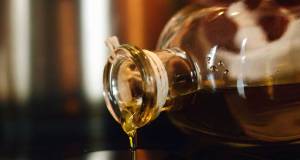
- Insight
- Posted
Home heating choices and air quality
How we heat our homes has a direct impact on the quality of air that we breathe. This impacts on our health. The impact is both local and national. Burning solid fuel – in an open fireplace or stove – generates fine particle pollution which affects the air in our own home and in the local neighbourhood. There are choices and actions we can take that will reduce this pollution.
This article was originally published in issue 34 of Passive House Plus magazine. Want immediate access to all back issues and exclusive extra content? Click here to subscribe for as little as €10, or click here to receive the next issue free of charge
Poor air quality has serious health implications both in the short-term (acute – temporary illnesses like headache, breathing difficulty or eye irritation) and the long-term (chronic – ongoing illnesses like asthma, reduced liver function or cardiovascular disease).
In Ireland, one of the main contributors to poor air quality is the domestic burning of solid fuels (coal, peat and wood). This is the main source of fine particulate matter pollution in our air. Particulate matter is very small particles which can be solid or liquid. Particulate matter is usually referred to as PM with a number after it to show how small the particulate matter is.
The EPA monitors two types of PM and compares levels to limit values in the CAFE (Clean Air for Europe) Directive and WHO guidelines. These are PM10 and PM2.5.
PM10 means that the particulate matter is 10 microns or less in diameter, small enough so you could lay 10 of these particles across the width of an average human hair. PM2.5 signifies that it is particulate matter of 2.5 microns or less in diameter – you could lay 40 of these particles across the width of an average human hair. The smaller the particles, the further they can penetrate into our lungs and cross into the bloodstream, damaging our lungs, heart and other organs.
Why is solid fuel burning so bad for air quality?
As well as being very inefficient in terms of heat production, open fires are the worst offenders in terms of producing harmful air pollution. Even burning solid fuel in stoves is an inefficient process. In fires and stoves, not all the solid fuel is fully burned. These unburnt particles leave the fireplace or stove by the chimney, or directly into the room they are heating. This causes both indoor and outdoor air pollution. The use of solid fuel for home heating is particularly problematic in or near towns and cities due to cumulative effects of multiple sources of the pollutant and the numbers of people exposed.
For stoves and biomass boilers, the pollution emission levels can vary depending on the choice of stove/boiler, the quality of the installation, the choice and quality of fuel used, how well the stove/boiler is maintained and the way it is used.
The Environmental Protection Agency (EPA) has developed an infographic outlining the ‘spectrum’ of heating options and fuel types. Any movement along the spectrum towards less smoky fuels and cleaner heating options will have a subsequent improvement on air quality.
It is recognised that cleaner heating options are not available to everyone. And that those people who are in or at the risk of fuel poverty need to be financially supported to make a transition to healthier forms of heating over time.
Passive homes
There is also a clear link between the reduction in harmful air pollution and climate change. As we make our homes more energy efficient, we will need less energy to heat our homes. If that energy comes in the form of solid fuel burning, then any reduction in that energy demand will lead to less production of local particulate matter pollution and consequently less greenhouse gas formation.
Improving our housing stock’s energy efficiency and moving to clean home heating choices will have the twin benefit of lowering emissions of the greenhouse gas carbon dioxide and improving air quality in Ireland.
Also, if we move towards the ‘best choice for air quality and health’ shown in the heating infographic, we will also reduce our emissions of greenhouse gases. Thus, dealing with our air quality issues will be better for our health, in the shorter term, and lead to long-term benefits for climate change. Many of the strategies that are outlined in the Government’s Climate Action Plan will have a beneficial outcome for air quality and health.
Evidence of the impact of different heating options on air quality
The EPA continually monitors air quality across Ireland and provides the air quality index for health and real-time results online at www.airquality.epa.ie. Results are updated hourly on the website, and people can log on at any time to check whether the current air quality is good, fair or poor.
The towns of Longford and Bray can be used to highlight the impact that solid fuel use has on air quality. Bray has a ban on the sale and use of bituminous coal. It is also part of the gas network. In contrast, Longford has no ban on the sale and use of bituminous coal. It is also not connected to the gas network.
The graph shows the concentration of fine particulate matter (PM2.5) measured during the winter heating season (January to March and October to December) for the years 2013 – 2018 at Bray town, Longford town, and for comparison Marino in Dublin. This graph allows us to the see the discrepancy between the two locations and the impact that additional solid fuel use has on air quality. Although the air at all three locations at times does not meet the WHO air quality guideline, it is worse in the smaller town of Longford due to the increased use of solid fuel for home heating. This situation is reflected across many towns in Ireland where solid fuel burning is prominent.

Above Graph showing particular matter (PM 2.5) in three Irish urban areas between 2013 and 2018. While there is a ban on the sale of bituminous coal in Marino and Bray, and both locations are on the national gas network, Longford has no such coal ban and is not on the gas network, so it relies more on solid fuel for home heating.
In conclusion
Ultimately, the best way to reduce air pollution is to move to cleaner ways of heating our homes and reduce the need for heating through improved insulation. This will significantly reduce our particulate matter levels in ambient air in Ireland, leading to much improved health outcomes for people. This is particularly important for at-risk individuals, such as young children and those with breathing problems.



